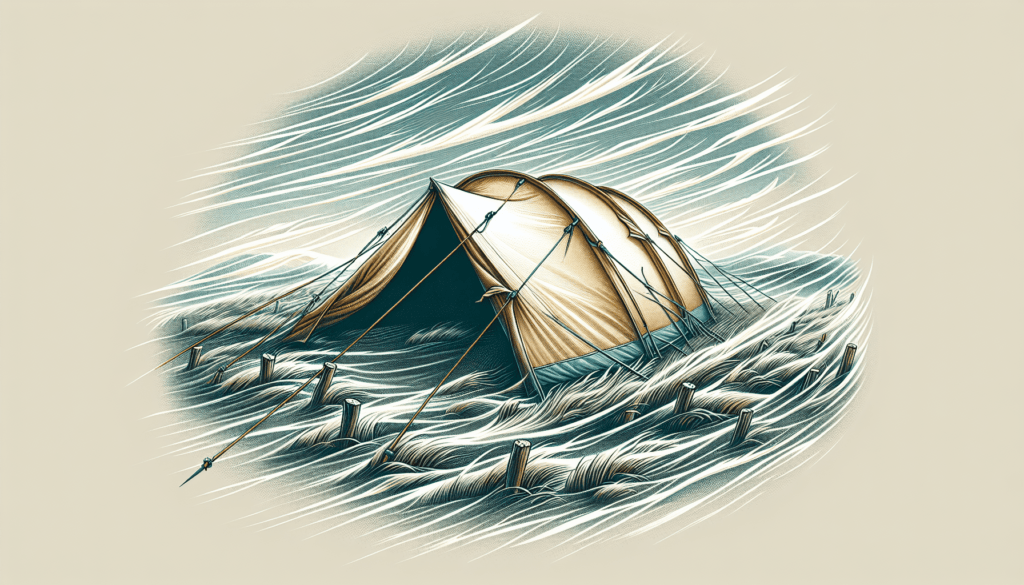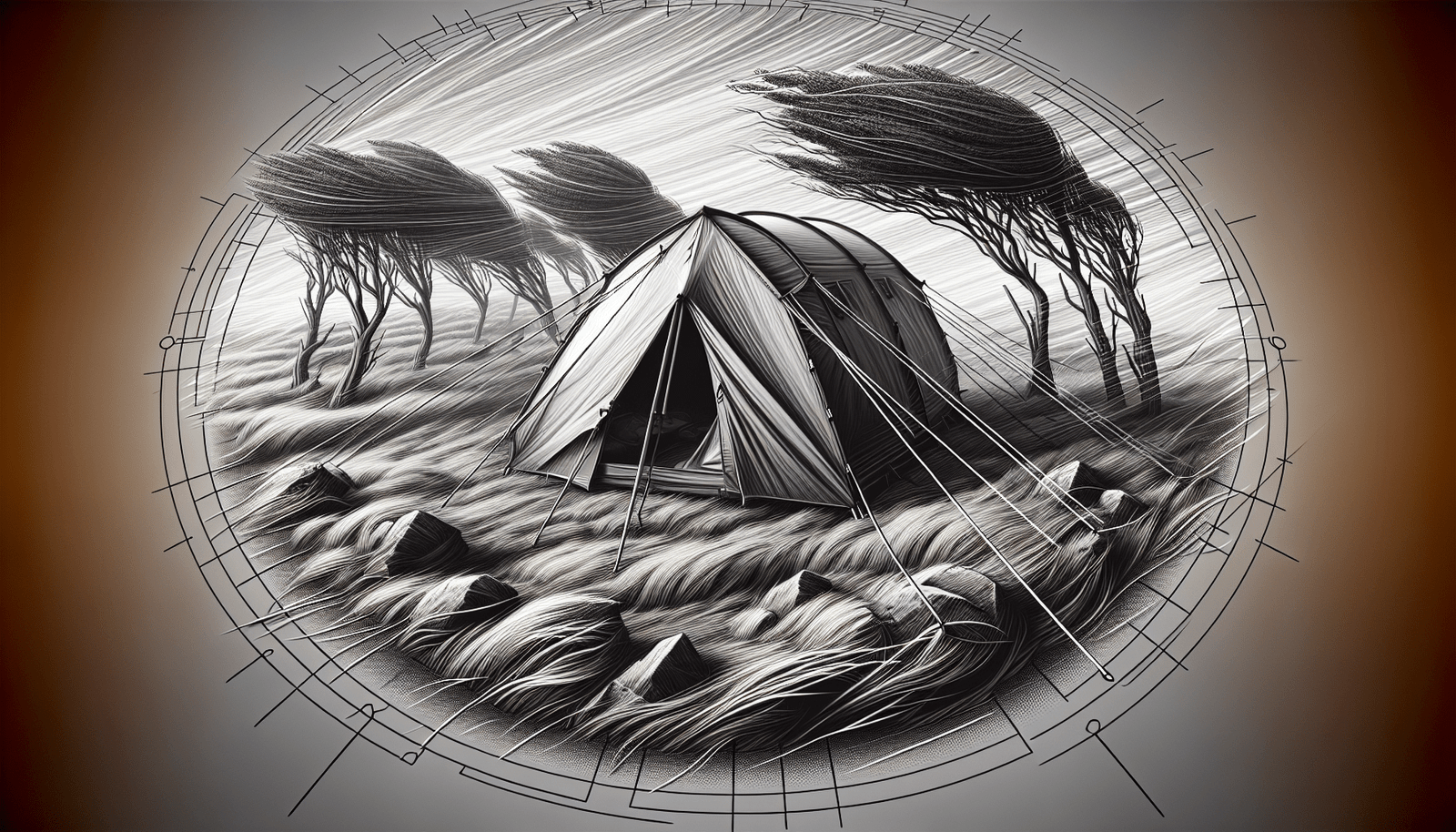Have you ever struggled with pitching a tent in windy conditions? You’re not alone. Setting up camp can be challenging enough, but when you throw wind into the mix, it can quickly feel overwhelming. However, with the right techniques and some patience, you can secure your tent even on the gustiest days.
Understanding Wind Dynamics
Factors That Affect Wind Behavior
Before you begin setting up your tent, it’s crucial to understand how wind behaves. Wind is influenced by numerous factors such as topography, weather patterns, and obstacles like trees and buildings. High-altitude areas and open fields are generally windier than sheltered valleys or thick forests.
Wind Direction and Intensity
Wind is not just about speed; it’s also about direction. A slight breeze from a constant direction is easier to manage than gusty, unpredictable winds. Always be aware of wind direction through natural indicators like the movement of trees or using weather apps.
Choosing The Right Tent
Tent Design
Some tents are designed specifically for high-wind conditions and are more aerodynamic. Dome and geodesic tents are better for windy conditions due to their shape, which helps to distribute wind pressure evenly.
| Tent Type | Description | Wind Resistance |
|---|---|---|
| Dome | Rounded, pole-based structure | High |
| Geodesic | Multiple intersecting poles forming a stable geometry | Very High |
| A-frame | Classic triangular shape | Medium |
| Tunnel | Long and cylindrical, supported by parallel supports | Low to Medium |
Tent Material and Stakes
The material of your tent also matters. Tents made of ripstop nylon or polyester are more durable against strong winds. Additionally, make sure you have extra stakes and guy lines. Aluminum stakes and reflective guy lines are particularly good choices.
Site Selection
Natural Windbreaks
Choose a campsite with natural windbreaks like boulders, dense tree lines, or small hillocks. These not only reduce wind speed but also help deflect the wind flow away from your tent.
Elevated or Low-lying Areas
Low-lying areas are usually less windy than elevated spots. However, be cautious of potential water accumulation in low areas in case of rain. Ideally, you want a spot that balances wind protection and drainage.
Pitching Techniques
Test the Wind
Before unpacking your tent, throw a small handful of grass or sand into the air to get a sense of wind direction. This helps you position your tent with the least resistance to the wind.
Position Your Tent Properly
Always face the narrow end of your tent into the wind. This minimizes the surface area exposed to the gusts, reducing wind pressure on the tent walls. If your tent has a designated wind entrance, use it.
Anchor Points and Stakes
Use multiple anchor points. Every tent has main stakes, but adding more can provide additional stability. Hammer your stakes at a 45-degree angle to the ground, aiming them away from your tent for better hold. Here are some recommended methods for improving your tent’s wind resistance:
| Method | Description | Benefit |
|---|---|---|
| Extra Guy Lines | Attach additional guy lines to secure more points of the tent. | Higher stability |
| Sandbags/Rocks | Place heavy objects on stakes and guy lines. | Increased weight anchor |
| Deep Stakes | Use longer stakes that can go deeper into the ground. | Better hold |
Use Guy Lines Effectively
Guy lines should be tensioned well but not too tight. Too much tension can cause the lines to snap, while too little can make them ineffective. Use adjustable tensioners to get it just right.
Adding Windward Anchors
If the situation permits, use additional windward anchors such as larger rocks or sandbags. These can be positioned against the wind-facing stakes to add extra weight and stability.

Secure Tent Flaps and Vents
Importance of Ventilation
Even in windy conditions, ventilation is crucial to reduce condensation inside the tent. Secure your tent flaps but keep vents open or partially open to allow for airflow.
Internal Support
Add internal support by using trekking poles or other sturdy items to help keep the tent structure firm from the inside. This is especially useful in dome or tunnel tents.
Weather Forecasts and Timing
Check Weather Conditions
Always check the weather forecast before setting out. Wind speeds above 30 mph can make tent pitching very challenging. Plan your trip and campsite accordingly.
Timing Your Setup
If possible, set up your tent during periods of reduced wind. Early mornings or late evenings when the wind often calms down can be better times for pitching a tent.
Emergency Procedures
Know what to do if the wind becomes unmanageable. Keep heavy objects inside your tent to prevent it from being lifted. Have a quick and safe evacuation plan in place in case conditions worsen.
Maintenance and Inspection
Regular Checks
Regularly inspect your tent for wear and tear, especially the poles and guy lines. High winds put considerable strain on these parts, and even small damages can become critical.
Storage
Store your tent properly when not in use. Moisture and UV exposure can weaken materials over time, making them less effective against strong winds.
Replacement Parts
Always carry spare parts like extra stakes, guy lines, and grommets. You never know when you’ll need a quick repair.
Practice and Experience
Rehearsals
Before hitting the actual campsite, practice pitching your tent in controlled settings under windy conditions. This can be in your backyard or a local park.
Learning from Mistakes
Each windy camping trip teaches you something new. Take note of what worked and what didn’t, so you can refine your technique for future trips.
Ask for Help
If you’re camping with others, don’t hesitate to ask for help. Extra hands can make a big difference when dealing with difficult conditions.
Packing Smart
Weight Distribution
Distribute the weight in your backpack wisely. A balanced load helps you stay stable while setting up the tent in windy conditions.
Essential Tools
Always carry essential tools like a mallet, additional stakes, and multipurpose sewing kits. These can come in very handy in emergencies.
| Tool | Purpose |
|---|---|
| Mallet | Securing stakes firmly into the ground |
| Extra Stakes | Additional anchoring points |
| Multipurpose Kit | Repairing rips and tears, adjusting guy lines |
| Trekking Poles | Using as internal supports |
Psychological Preparation
Confidence and Patience
Prepare yourself mentally for the challenge. Confidence and patience go a long way in making the process smoother and less frustrating.
Avoiding Panic
Wind can make simple tasks seem daunting. Stay calm and methodically follow your pitching plan. Panicking can lead to mistakes, making the situation worse.
Team Coordination
If you’re camping with a group, ensure everyone understands their role in the tent-pitching process. Clear communication can help in quickly securing the tent, reducing the time it’s exposed to the wind.
Safety Precautions
Personal Safety
Never compromise on personal safety. If the wind becomes too strong, it’s better to find natural shelter or retreat than risking injury.
Securing Equipment
Ensure all your camping equipment is secured. Strong winds can easily blow away lighter items, causing both inconvenience and potential hazards.
Shelter Alternatives
In extreme conditions, consider alternative shelter options like using your vehicle or finding a pre-existing structure to use as temporary shelter.
Adapting to Changing Conditions
Continuous Monitoring
Always be aware of changing wind conditions. Be prepared to make adjustments to your tent setup as necessary, ensuring that stakes and guy lines remain taut and functional.
Flexibility
Be flexible with your camping plans. If conditions change dramatically, be willing to adapt, whether that means changing your campsite or employing different sheltering techniques.
Backup Plans
Always have a backup shelter and exit strategy in place. Whether it’s a backup tarp, an emergency bivy sack, or knowing the quickest route to more substantial shelter, preparation is key to staying safe and comfortable.
By following these detailed steps, you can confidently pitch a tent even in challenging windy conditions. Preparation, understanding your environment, choosing the right equipment, and employing the proper techniques can make all the difference. Happy camping!
Support us! Wilderness gear Pro may earn a small commission from affiliate links in this article. Learn More

